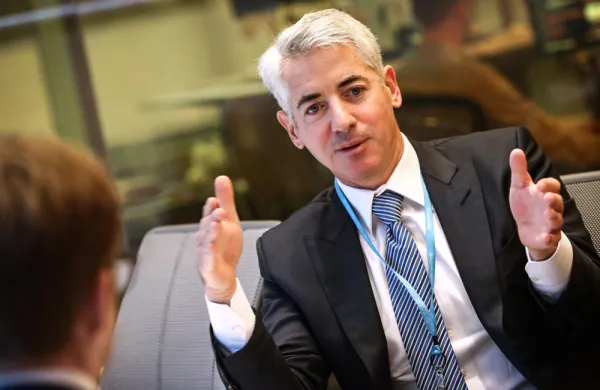Latin America's capital markets have had a surprisingly good run these past three years. How much longer will the winning streak last?
| Latin America needs some blue-sky thinking. |
If history is any guide, Latin American markets must come undone sooner rather than later. Latin America is growing, but it is hardly a picture of robust health. Its governments are still over-indebted, investment is insufficient and the region depends heavily on commodity exports. By tradition, bursts of growth in Latin America are followed by recession, devaluation and political upheaval.
And yet, investors can't get enough of Latin America.
Mexico's IPC stock market index rose more than 40% in dollar terms last year. It rose 48% in 2004 and 31% the year before that. Stock prices in Brazil rose more than fourfold from 2003 to 2005 in dollars. Latin American bonds returned more than any other class of emerging market debt last year. In November, spreads on Latin American bonds fell to a record low. Even Latin America's confetti currencies have done well. Brazil's real climbed 68% against the dollar since touching bottom in October 2002. Strong markets and plentiful liquidity have triggered innovative capital market transactions – many of them highlighted in this month's issue – ranging from the biggest local currency global bond ever issued by a Latin American sovereign to a successful hostile takeover in Chile. Even Argentina's $81.8 billion debt exchange that ended its four-year default was a triumph of financial engineering. Once-moribund primary equity markets are very much alive. Last year 22 Latin American companies, from utilities to airlines to an Internet service provider, went public in deals worth $5.09 billion. In 2004, 11 companies launched IPOs that raised $2.16 billion from investors.
Brazil matters a lot. It's Latin America's biggest economy and it has benefited the most from the commodity boom. Polls indicate that populist candidates aren't likely to make much headway in the October presidential elections, despite President Luis Inácio Lula da Silva's corruption scandal. Growth should accelerate as interest rates fall, releasing pent-up demand. Economists say the Central Bank could cut its benchmark interest rate by 300 basis points to 15% in 2006, a historic low. Growth in Brazil has lagged the rest of Latin America, not to mention developing Asia and Eastern Europe. In 2005, only Haiti, Jamaica and Guyana grew more slowly than Brazil's 2.5% expansion. Latin America averaged 4.3%.
Brazil's Lead
Roberto Setúbal, president of Brazil's Banco Itaú, Latin America's most successful bank, is hoping for the best. "In moments of crisis, markets react very quickly and close fast," he says. "But now, with more stability and predictability in the markets, prices and liquidity are favorable." He expects Itaú to increase lending 25%-30% this year, even after an equally large increase in 2005. Yet Setúbal admits he is puzzled about the country's growth rate. "No one can understand why economic growth is so weak. We used to say it was because of inflation, then because of our external vulnerability. Now we are debating whether it is due to high interest rates, heavy public debt and the government's budget deficit, which I think represent the final problems of the economy that need to be settled."
Mohamed El-Erian, outgoing head of emerging markets at Pimco, the largest investor in emerging-market debt with about $17.6 billion invested in Latin America, has not lost faith with Latin America – far from it. He says that if all goes well during this election year, then what he calls "Latin America's virtuous cycle" will be significantly reinforced. "This is going to be a watershed year. The only issue out there will be whether Latin America can navigate an eventual adjustment in the US. This is important because there is a lot of money on the sidelines – both in portfolio investment and in direct investment – that is underexposed to Latin America." If investors become convinced that Latin America's new leaders will not embark on disastrous policies, such as more protectionism, interventionism and currency devaluations, then net capital inflows should recover.
El-Erian points out that Argentina's 2001-2002 collapse proved that financial crises can be contained without contaminating the entire region. A second test came in 2002, when Brazil demonstrated it could handle political change and maintain economic policy continuity. This year will show whether or not Latin America can handle a punishing election calendar without economic dislocation. If all goes well then, investment flows will pick up. That would be a welcome change. Latin America has been exporting capital for six consecutive years as it pays down debt. According to the UN's Economic Commission for Latin America and the Caribbean, the region became a net exporter of capital in 1999 and has sent about $215 billion overseas since then. Last year alone it exported about $70 billion.
Brazil's Finance Minister Antônio Palocci promises all will be well this year. "There is nothing in the scenario going forward that could present an obstacle to growth," he says. "Next year will be a year of strong growth. Interest rates are falling and will continue to fall as long as inflation allows. There is no room to relax on inflation control."
Yet some investors still have that gnawing suspicion that trouble could lie just around the corner.
Desmond Lachman, a resident fellow at the American Enterprise Institute in Washington, commented in September that it is obvious that Latin American markets would surge when liquidity is plentiful. But he advises caution. "It should also have come as no surprise that, in their desperate search for yield, global bond investors would drive down emerging market bond spreads to levels last seen before the 1997 Asian financial crisis," he warns. "In that quest, these investors have not been particularly discriminating between good and bad Latin American credits. What does come as a surprise, however, is that many investors now appear to be taking the market's present ebullience as an indication of the emergence of a new paradigm. While there can be no gainsaying that certain macroeconomic progress has been made over the past few years, one has to ask how long one might expect political conditions in Latin America to be conducive to macro-economic reform."
And Jean-Dominique Bütikofer, head of emerging market debt at Zurich's Union Bancaire Privée, worries about the outcome of the elections. "We don't see the EMBI going up to 700-900 basis points, but our work will be on identifying the triggers that will push countries into trouble. The mechanism will be different in each case. The asset class has improved and countries have done their homework, but we have to look at what kind of triggers and issues could push countries into difficulties: excessive currency appreciation, weak banking systems, excessive leverage, unemployment, politics. And what really has changed for the average South American? Have they really gained from growth in the last years? Jobs are hard to get, their quality of life has not changed."
Even Lourdes Flores Nano, a leading candidate in Peru's April election, echoes the same concerns. Flores, a conservative, says: "Our economic figures are very good but there are very tough social problems that need to be the main target of the next government. That's the only way to get people to support a market economy. They think a market economy does not benefit them. It's only by solving these people's daily problems that we can achieve stability." Peru, she says, needs a reform of the state that can bring benefits to everyone. "It means investing in education, in health, in integrating rural areas and supporting small companies," she says.
Investors have started to hedge their bets. UBP's Bütikofer says: "The key thing is to make a good country selection to separate countries with economic and political problems and be able to short or hedge your market exposure." Jonathan Binder, a partner at Florida hedge fund Consilium, says: "The uncertainty over what all the elections will bring in terms of economic policy will hold Latin American debt back next year. We're nearing the point where there's not enough extra reward for investing in these markets.'' Binder says yields on Latin American bonds could rise as much as 200 basis points this year. If he's right, that would be the biggest jump since 1998.
Overvalued?
And yet, El-Erian points out that Latin America's balance sheet is strong enough to withstand the kind of turbulence that in previous years would have triggered a debt crisis. Central Bank reserves are at record levels. Budget deficits are narrowing and issuance of fresh Latin American debt is also drying up, driving yields down. Most governments have already refinanced external debt maturing in 2006. Mexico has even refinanced debt due through 2007, and it is also aiming for a balanced 2006 budget. Instead of issuing rafts of dollar global bonds, governments are increasingly able to finance their declining budget deficits in their local capital markets.
Argentina and Brazil both used growing currency reserves to prepay debt to the International Monetary Fund and the Paris Club of government lenders, further improving their debt profiles. President Néstor Kirchner said severing ties with the IMF was a historic event for Argentina. "We're trying to pull out of the hell that we fell into," he told supporters in December. "We're solidifying our strategy of debt reduction to a level that is compatible with growth and payment possibilities. At the same time, we are winning the freedom to make national decisions."
No Jolts
Nicolás Aguzín, head of Latin America at JP Morgan, expects that all will be well. "There is so much liquidity that the markets could really go through this year without any significant jolts," he says. "Macro conditions in Brazil and Mexico and Chile are sound, so having these three countries with a stable outlook helps you to rule out a significant Latin American catastrophe." The deleveraging of Latin America is not just a public sector phenomenon. The gross debt-equity ratio of all listed non-financial Latin American companies fell by nearly half to 66% in the five years through December 2005, according to data from Economática, a capital markets data provider in São Paulo. Although companies' aggregate debt load rose 20% to $262.35 billion in the same period, their market capitalization rose 140% to just over $1 trillion. In 2005, Moody's not only raised Brazil's credit rating one level to Ba3 – three notches below investment grade – but also lifted aircraft manufacturer Embraer to a Baa3 investment grade. Brazil now has six companies that have pierced the sovereign ceiling to achieve higher ratings than the government. If Brazil, Peru and Colombia keep cutting debt and focusing on pro-growth reforms, they could be promoted to investment grade within the next three to four years.
| Nicolas Aguzin |
One thing seems clear enough. Markets are more likely to be hampered by entirely unpredictable events divorced from financial market dynamics. An unwelcome surprise in the elections, a terrorist outrage, crisis in the oil markets or a collapse in commodity markets could drive billions of dollars out of the emerging markets and into dollars or gold, putting at risk much of the progress Latin America has made in recent years.
Optimists will say the probability of these dangers is low, balance sheets are strong and the greater risk is to remain underweight in an asset class that has consistently outperformed developed country markets. Says El-Erian: "Brazil may look expensive at these prices, but it is still cheap." A smooth political transition in Brazil and Mexico without undue global economic volatility will trigger a further drop in yields as money parked in cash is put to work in Latin America. JP Morgan's Aguzín says: "People are paying for growth. Growth is not looking remarkable right now, but just look at how Brazil can achieve any growth with such high interest rates. If you manage to transition through the election period smoothly, then conditions could improve a lot. People would see the opportunity to grow. Although spreads are very tight the reality is that they are still interesting compared with the US or Europe."
If things do go moderately well in 2006, then a lot of the innovations in developing Latin America's local capital markets in recent years will probably begin to bear fruit.
Pundits grumble about the inertia of outgoing Mexican President Vicente Fox, but they overlook the impressive work done by Finance Secretary Francisco Gil Díaz and his team in streamlining Mexico's capital markets. At the end of last year, Congress approved reforms improving corporate governance and protection for minority shareholders. The legislation requires companies to set up independent audit and corporate governance committees. It allows minority shareholders to appoint board members with only 10% of votes and makes it easier for them to sue management. It also allows private companies to access the markets without meeting full regulatory and reporting requirements for fully-fledged public companies. Mexico City Stock Exchange officials say the reforms could double the number of listed companies to 260 in five years.
The São Paulo Stock Exchange has created new market segments, such as its celebrated Novo Mercado, and a range of new indices. This spirit of innovation has reinforced Brazil's equity culture – strong by Latin American standards – enabling 10 companies to launch IPOs in 2005, netting $2.77 billion. In comparison, Mexico had just three IPOs that raised $850.6 million. Brazil's government has promised to make local debt markets more accessible for foreign investors by simplifying taxes and regulations.
Smaller markets are making progress, often with support from multilateral development agencies. In 2005, Lima's Universidad de San Martín de Porres became Peru's first private university to issue bonds when it placed the first $15 million tranche of a $30 million seven-year program. The bond is backed by future tuition receipts at six of the university's faculties and is supported by a 30% partial guarantee from the World Bank's private sector arm, the International Finance Corp. Strong demand from local investors starved of high quality private sector assets drove pricing down to Libor plus 300 basis points, better than the rate of Libor plus 550 basis points previously available to the university.
| Mohamed El-Erian |
In Colombia, the Inter-American Investment Corp., the private sector agency of the Inter-American Development Bank, launched a small but pioneering local currency bond. It sold 150 billion pesos ($65.9 million dollars) in five-year bonds yielding 76 and 95 basis points below the benchmark TES rate. Crucially, the IIC decided to lend the issue proceeds to local private sector borrowers, instead of swapping the local currency into dollars as larger international agencies have done with their previous local currency issues. "We had listened to Colombia's small and medium enterprises and they told us that they did not want to borrow in dollars but wanted local currency financing," says Jacques Rogozinski, the IIC's general manager. "So we started to look at what the IIC could do and after a year of banging our heads we moved ahead with this. It was the first time a multilateral had done a local currency offering and placed that money locally."
This is a breakthrough for Colombia's markets but it is also an important innovation for multilateral agencies struggling to find a new role. Demand for their traditional product – dollar loans to public sector infrastructure projects or macroeconomic adjustment programs – is declining. In the future, these agencies could support development of Latin America's private sector by channeling resources through domestic capital markets as they emerge as the main source of financing for corporates. Setúbal at Itaú says: "With a benign global outlook and a stable economy in Brazil and lower interest rates, the outlook will be better than [in 2005] and corporates should become more active in the capital markets and rely less on loans. We think there will be more intense activity in the equity and fixed-income markets and in investment-banking activities."
Latin American governments are issuing local currency benchmark bonds to flesh out domestic yield curves and to help derivative markets develop. Deregulation is allowing more foreign investors to participate in these markets, bringing added depth and liquidity. And as governments reduce debt loads so they open space in the markets for more private sector issuers. Global investors are gingerly buying up more corporate debt from highly-rated blue chips. These companies are becoming more creditworthy, yet deliver much more yield than similarly-rated issuers in Europe or the US.
All this sounds a little too good to be true. Some investors worry about becoming complacent and failing to notice market alerts that signal the next Latin American financial crisis. What if they are right, and Latin America does revert to type?
An incoming populist government would certainly be able to raise spending, meddle in local markets and rebuild trade barriers. But if that were to happen, would yields necessarily soar? Liquidity is so abundant and government finances in such good shape that most countries could stave off trouble for a while. After all, oil prices are sustaining Venezuelan bond prices very nicely. Few countries have vast oil reserves to fall back on. With time, asset prices would quickly dive in anticipation of the inevitable results of heterodox policies: inflation, currency depreciation, falling incomes, rising debt, capital flight and eventually political unrest. Investment would grind to a halt, endangering the emergence of the private sector as Latin America's engine of growth. And skeptics like Bütikofer would be vindicated. "Latin America is seen as the farming continent for the rest of the world, the commodity place," he says. "I don't see many other specific areas or broad markets where Latin America could gain momentum. We don't see Latin America developing many other sectors."






